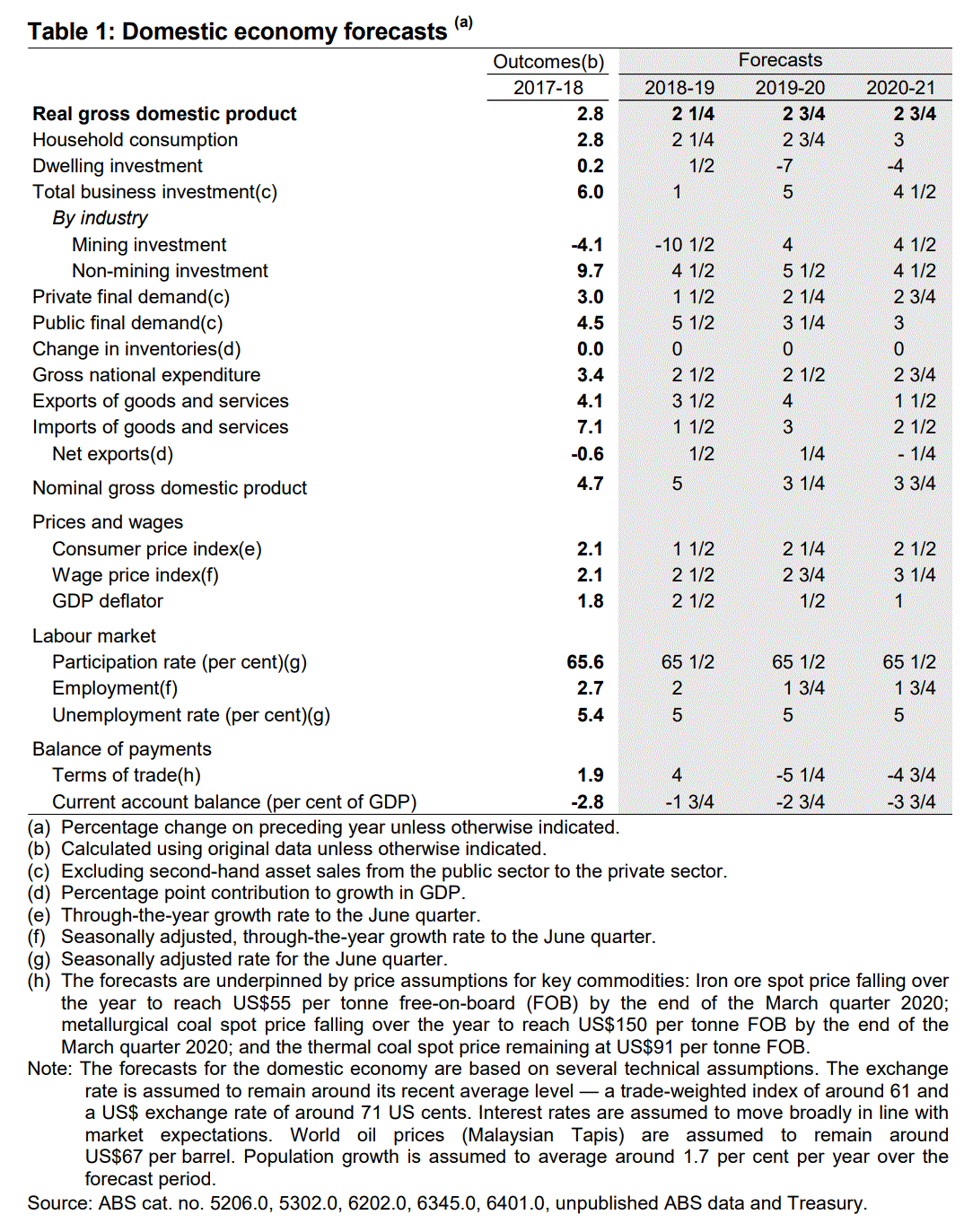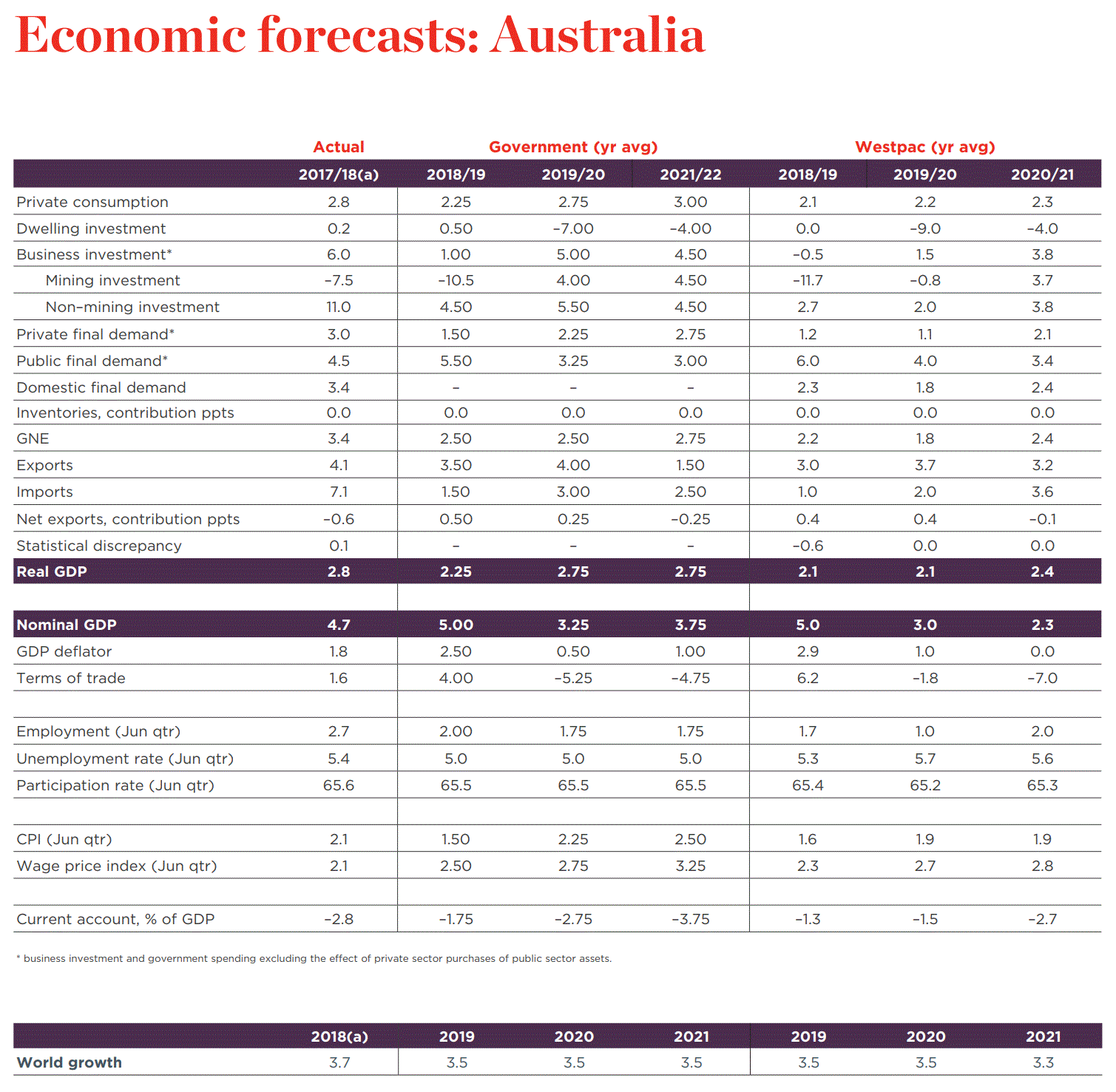Here they are:

OK, so the external prices are pretty good. Iron ore is unchanged from $55FOB which is more like $65CFR. The events surrounding Vale make that conservative for the next year, probably about right for 2020/21 and too high the following year as China slows. Coking coal prices of $150 within one year are reasonable. Further out they are too high. Thermal is decent too if on the high side. Oil and the AUD are fair enough.
It is reasonable to expect better than forecast revenues from commodities for the coming year, roughly right for 2020/21 and a big problem thereafter, assuming there is no end of cycle event.
That’s where the good news ends. The domestic outlook is a joke. Pretty much every number is too optimistic, from growth to unemployment.
This will mean that any good news from commodity prices will very likely be offset by bad news from domestic weakness.
Westpac has done some more comprehensive numbers which are a solid base case (if also a bit optimistic for me, especially wages):

Ratings agencies see it much the same way. Moody’s:
Australia’s Commonwealth budget position has improved significantly during the past year, assisted by strong revenue growth, reflecting higher-than-expected commodity prices and strong employment growth.
At the same time, the government has provided support for the economy through its infrastructure spending, while overall spending growth has remained contained.
Looking ahead, the Budget indicates an ongoing, but modestly slower, pace of fiscal consolidation than was previously indicated at MYEFO.
On the other hand, there are risks to the fiscal outlook. The world and Chinese economies are slowing modestly, while the pace of Australia’s domestic economy will also slow this year. In this climate of slower growth, the impact of still-weak wages growth, lower housing prices and a potential easing of employment growth are key uncertainties for spending and government revenues, though personal tax cuts should help to offset these factors.
Overall, Australia’s high levels of debt affordability and moderate debt burden will remain in line with its Aaa rated peers.
Fitch:
“The deficit and debt targets presented in Australia’s pre-election budget on Tuesday are broadly in line with Fitch Ratings’ expectations when we affirmed Australia’s ‘AAA’ rating with a Stable Outlook last October. The budget preserves a path for reaching an underlying cash surplus in FY20. The commitment to prudent fiscal management has been a supporting factor for Australia’s ‘AAA’ rating.”
“While Fitch Ratings sees a return to an underlying cash surplus by FY20 as achievable, we anticipate lower revenues and a narrower surplus than in the budget, based on our forecasts of slightly lower GDP growth and employment than in the budget. The difference, however, is not material to our credit outlook.”
“The proposed income tax cuts in the budget would provide some support for the economy, which has slowed since mid-2018, but make the fiscal trajectory even more sensitive to commodity prices, and outturns for GDP and wage growth. As such, the budget could be more sensitive to domestic and external risk factors.
“Federal elections are due in just over a month. Fitch Ratings believes there is a general cross-party consensus for sound fiscal management in Australia. Of course the specific policy approach could well shift after the elections.”
S&P:
Global Ratings said today that its credit rating on Australia (AAA/Stable/A-1+) reflects its expectation that the general government, including state and local governments, will return to surplus by the early 2020s. When we revised our rating outlook in September 2018 based on a return to fiscal surplus, there was significant market uncertainty around Australia’s political and future fiscal position. The federal budget released today supports our view that the government is on track to return to surplus. The central government will achieve stronger fiscal outcomes than we anticipated in the near term because of robust commodity prices and terms of trade. This has helped to deliver higher revenue growth. At the same time, better labor market conditions have lowered expenditure outflows compared with previous budgets. These stronger outcomes have helped to fund new policy announcements in today’s budget.
In short, once commodity prices diminish, which is foreseeable in the next term of government, there will be chaos again for external revenues with no domestic offset resulting in a round of pro-cyclical austerity.
A problem for another day. Or, more to the point, another government.

